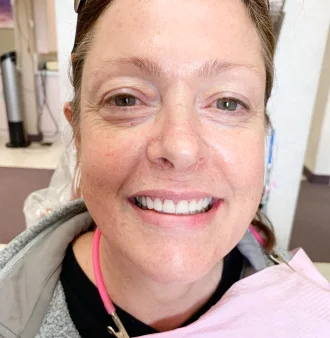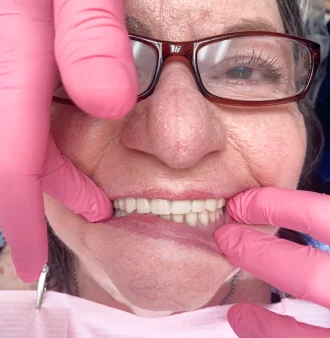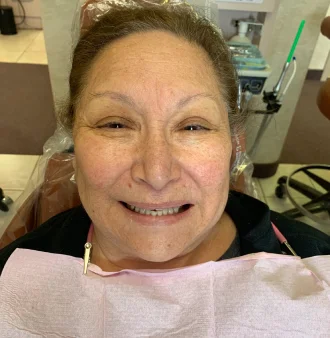Teeth Whitening in Mesa AZ
Although there are a number of at-home teeth whitening products, the fastest and easiest way to restore a bright and healthy-looking smile is through professional, dentist supervised teeth whitening service. At EVDP, we offer professional teeth whitening treatment in Mesa, AZ.
Benefits
- Enhances Smile Aesthetics: Teeth whitening significantly brightens and whitens teeth, enhancing the overall appearance of your smile.
- Boosts Self-Confidence: A brighter smile can increase self-esteem, making you feel more confident in social and professional settings.
- Quick and Noticeable Results: Professional whitening provides immediate improvements, often noticeable after just one session.
- Removes Stains: Effectively lifts and removes surface stains caused by foods, drinks, smoking, and other factors that discolor teeth.
- Relatively Affordable: Compared to other cosmetic dental procedures, teeth whitening is a cost-effective way to improve the aesthetics of your smile.
- Safe and Non-Invasive: Done by a professional, teeth whitening is a safe and non-invasive method to enhance dental appearance.
What people say
about Us
I've been a patient for fifteen years and I couldn't imagine going elsewhere. Everyone is professional, kind and the best of the best! I've had most every oral procedure and each has been flawless.
They are always friendly, attentive, have quick service and respond quickly to questions.
EVDP is amazing, the patient care is top notch and they do beautiful work! I felt so taken care of as patient and strongly recommend their services!
The visit was great I hope I can come up with the money some he can fix my mouth for me. At 53 have never had a kinder Dr. in my mouth. Wish I had insurance so he could do my work today.
Everyone was helpful and kind. I appreciate the introductions of who people were. My stay was pleasant and I'm hopeful my tooth problem is resolved.
When you visit our office, we will provide you with a full assessment based on your situation and your goals. We can then discuss professional in-house methods for restoring the natural color of your teeth. We are able to reverse the damage present, in many cases, giving you healthier and whiter teeth.
Teeth whitening is a non- invasive process of brightening the smile. This applies to any product or procedure that restores teeth to their porcelain color. Many people long to have whiter and brighter teeth but are unsure how to make it possible. While you can find a whitening kit at home or whitening gels promising to provide a perfect smile, it is best to come in to see our team for a more advanced and effective solution.
FAQs for Teeth Whitening
Is Whitening Treatment Safe for Your Teeth?
The whitening process done in our office is safe. It is done under the supervision of your dentist. While there can be some side effects with products purchased otherwise, our methods are safe and reliable. We recommend avoiding tooth bleaching and other types of bleaching products when used at home. This can damage the gums or tissues in the mouth. Most often, this type of treatment is also less effective. Products like whitening strips and customized tray products from a box are less beneficial overall than visiting our office.
Who Benefits from Tooth Whitening?
Many people benefit from tooth whitening. It can be very effective for individuals who have:
- Yellowed teeth
- Stained teeth
- Discolorations due to food
- Dull looking teeth
- Healthy enamel, but it is discolored
If you are unsure if this process can benefit you, we encourage you to come in for a dental appointment. Our team will discuss the options available to you. Our goal is always to protect the tooth enamel, which is the outer surface of the teeth. It is not possible to replace the enamel, but we can remove surface stains from it.
What Is the Most Common Whitening Method?
The answer is professional bleaching. The first thing to do is to go to a dentist to have your teeth assessed and to determine if you are suit for this kind of whitening or not. If yes, the professionals will put a gel or some sort of rubber to protect your gums. After this, they will apply the whitening product on the teeth, which is usually made of carbamide peroxide or hydrogen peroxide.
How Do We Whiten Your Teeth
After you come in for a dental appointment, we will then discuss your oral health. Remember, tooth whitening does not improve the actual health of your teeth. It does not protect the gums, either. For this reason, you may benefit from a dental cleaning before a whitening application. Your dental care provider will give you this information.
Then, we will introduce you to our whitening products. We use only products with an ADA Seal of Acceptance – and any over the counter products you may be considering should always use this as well.
With our method, we use a tray whitening system. This is not the same as using an at home product. Our products offer a customized tray – one we create with you during your first visit. We make an impression of your teeth for it. This then allows us to create a comfortable as well as reusable whitening tray. It fits properly and perfectly into your mouth. As a result, it creates the best contact with your teeth possible.
From here, we use a whitening gel applied to the inside of the trays to begin the process. This whitening treatment does not take long. It does not hurt, either. Rather, you will need to apply the whitening gel in the tray for the next few days. In doing so, it will work to safely remove surface stains from your teeth. We’ll follow up with you to ensure you are satisfied with the results you get.
How Long Will It Take?
The average timeframe is three to four weeks. By then, you will have visible results. This will require you to visit your dentist around three times. After your first appointment, you will continue applying the whitening product in your home for a period of two to four weeks. You need to do this for 30 minutes to an hour per application, though sometimes the required hours are more, depending on the product you’re using and depending on your dentist.
When Should I Brush My Teeth?
You need to brush your teeth at least twice a day even when you are applying whitening products. Brush your teeth at least once during daytime. We recommend that you brush before applying the whitening product. Also, brush your teeth before going to bed at night. Use fluoride toothpaste.
How Can I Look After My Teeth After Whitening?
After applying the product for a period of four weeks, or as the dentist requires, you need to look after your teeth to maintain the whiteness. You need to stay away from drinking beverages and eating foods that cause stains. Your dentist will tell you what foods and drinks to avoid. Most importantly, stop smoking, as this causes discoloration and staining. Of course, regular visit to the dentist is important too.
Are There Other Whitening Procedures?
Aside from the one already mentioned, power whitening or laser whitening is now gaining popularity. In this procedure, the professionals will put a rubber dam over your teeth to serve as protection for your gums. After this, they will paint a bleaching product all over your teeth. The final part of the procedure is using a laser to activate the chemicals. Studies show that using this procedure can make the teeth five to six times whiter. The results can also be quickly achieved.
Can You Use Whitening Products If You Have Sensitive Teeth?
If you have any type of sensitive teeth, we recommend letting our team know before you visit. We can then determine what the cause of this is so we can treat it if necessary. Tooth sensitivity can occur for many reasons including decay and cavities. We’ll need to treat those conditions to ensure you have the best possible outcome with any type of whitening product.
How You Can Benefit From Teeth Whitening?
The investment in tooth whitening technology and resources like this can significantly improve your overall dental health and give you a boost of self-confidence. If you, like many other people, hate to smile or talk to others because of the lack of luster on your teeth or your dingy rather than bright smile, we can help you. White teeth do not necessarily improve the overall health of your teeth, gum line, or mouth, but it can significantly improve your overall oral hygiene if you continue to brush and floss on a daily basis.
How Much Will This Cost Me?
There is no definite cost to this. One thing’s for sure, power or laser whitening is more expensive than the more traditional professional bleaching. You can ask for an estimate from the dentist before you start the procedure. The charges usually vary from state to state.
Will the Effect Last Long?
Yes. Your teeth will stay white for around three years. However, you must stay away from stain-causing foods and beverages and quit smoking, as already mentioned above. These habits will affect the effect of the whitening product.
Are There Side Effects?
The common minor side effects are sensitivity to cold during or immediately after the whole procedure or treatment. You might also experience white patches on the gums, sore throat or discomfort in the affected area. However, these are normally temporary and will immediately go away after the treatment. But if the side effects persist, it is better to consult your dentist.
Can I Use Home Whitening Kits?
This depends on the kind of product you’re using and of course, with recommendation from your dentist. Some of the products don’t work. The most common kits are paint-on whiteners and whitening strips. They only work to remove discoloration, though. They are not likely to help you with any type of dental concern present, though. The active ingredient in them will vary – be sure it is one you are safe to use.
There are also bleaching agents available. However, we do not recommend using any type of bleaching agent at home until your dentist approves it. It is important to have a thorough dental exam before having this type of procedure done.
Although teeth whitening toothpaste is available in the market, you may realize that sometimes they probably are not the best treatment as teeth whitening toothpaste is designed for very gentle and minor stains.
Are There Instances When Whitening Won’t Work?
Like we said on the preceding paragraph, this depends on the product you’re using, especially if you’re using home whitening kits. However, laser whitening and professional bleaching always work on natural teeth. Just take note that whitening products don’t work on false teeth or dentures.
How Does it Work?
To give you the dazzling color you desire, we use a tray whitening system. First, we make an impression of your teeth – this allows us to create comfortable, reusable whitening trays that are custom-made for your mouth. Whitening gel is then used inside the trays over the next few days to painlessly brighten your smile. It’s as easy as that!
Get Started with Teeth Whitening Treatment
Having a skilled, professional dental team is crucial to the success of the procedure. You will achieve best results if you approach the right professionals.
If you are ready to consider how tooth whitening can benefit you, we encourage you to schedule a consultation for a full consultation and oral health examination. We can then recommend methods for improving your smile, improving your oral health, and achieving the fantastic bright smile you are seeking from us.
If you are planning to get an effective Teeth Whitening in Mesa, AZ, please schedule an appointment and visit our office. We have a great team of professionals who work responsibly and honestly to whiten your teeth and to take care of your other dental needs.
Your Smile's Happy Place! Come visit us and see why
Fun atmosphere, friendly staff, and zero dentist nightmares


















